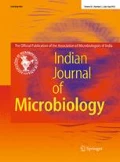Abstract
For bacteria sampling studies, various collection methods have been used to identify bacteria. To obtain accurate information about bacteria, high quality samples should be obtained. In order to obtain a high quality sample, a stable and large number of DNA copies must be collected. This study compared the efficiency of different methods of bacterial gDNA extraction and bacteria collection according to swabbing solution volumes and types. The efficiency of bacterial genomic DNA extraction was compared using a AccuPrep® Genomic DNA Extraction kit, a QIAamp® DNA Mini kit, and a MOBIO® DNeasy PowerSoil kit. The DNA Mini kit was shown to extract the highest amount of gDNA, and sub-experiments were conducted using this kit. Phosphate-buffered saline and phosphate-buffered saline with 0.1% Tween 20 were used as collection solutions of various volumes (0, 40, 50, 60, 70, 80, 90, 100, 110, and 120 μL) using cotton swabs. Bacteria collection efficiency was highest when 70 μL PBS was used. The target strains collected in this experiment were Staphylococcus aureus and Escherichia coli, and these were quantified using the number of colony-forming units, DNA concentrations, and the number of DNA copies. These results can be used to efficiently bacterial collection for experiments in various fields.




Similar content being viewed by others
Abbreviations
- PBS:
-
Phosphate-buffered saline
- PBST:
-
Phosphate-buffered saline with 0.1% Tween 20
- E. coli :
-
Escherichia coli
- S. aureus :
-
Staphylococcus aureus
- CFUs:
-
Colony-forming units
- MSA:
-
Mannitol salt agar
- MAC:
-
MacConkey
References
Daniel RJNRM (2005) The metagenomics of soil. Nat Rev Microbiol 3:470
Qin J, Li R, Raes J et al (2010) A human gut microbial gene catalogue established by metagenomic sequencing. Nature 464:59
Gevers D, Knight R, Petrosino JF et al (2012) The Human Microbiome Project: a community resource for the healthy human microbiome. PLoS Biol 10:e1001377
Lax S, Hampton-Marcell JT, Gibbons SM et al (2015) Forensic analysis of the microbiome of phones and shoes. Microbiome 3:21
Hospodsky D, Qian J, Nazaroff WW et al (2012) Human occupancy as a source of indoor airborne bacteria. PLoS ONE 7:e34867
Verdon TJ, Mitchell RJ, van Oorschot RAJFsiG (2014) Evaluation of tapelifting as a collection method for touch DNA. Forensic Sci Int Genet 8:179–186
Hanssen EN, Avershina E, Rudi K et al (2017) Body fluid prediction from microbial patterns for forensic application. Forensic Sci Int Genet 30:10–17
Anzai-Kanto E, Hirata MH, Hirata RDC et al (2005) DNA extraction from human saliva deposited on skin and its use in forensic identification procedures. Braz Oral Res 19:216–222
Pang B, Cheung BJLM (2007) Double swab technique for collecting touched evidence. Legal Med 9:181–184
Grice EA, Kong HH, Renaud G et al (2008) A diversity profile of the human skin microbiota. Genome Res 18:1043–1050
Pechal JL, Crippen TL, Benbow ME et al (2014) The potential use of bacterial community succession in forensics as described by high throughput metagenomic sequencing. Int J Legal Med 128:193–205
Fierer N, Hamady M, Lauber CL et al (2008) The influence of sex, handedness, and washing on the diversity of hand surface bacteria. Proc Natl Acad Sci 105:17994–17999
Ying S, Zeng D-N, Chi L et al (2015) The influence of age and gender on skin-associated microbial communities in urban and rural human populations. PLoS ONE 10:e0141842
You HS, Lee SH, Ok YJ et al (2019) Influence of swabbing solution and swab type on DNA recovery from rigid environmental surfaces. J Microbiol Methods 161:12–17
Fierer N, Lauber CL, Zhou N et al (2010) Forensic identification using skin bacterial communities. Proc Natil Acad Sci 107:6477–6481
Desjardins P, Conklin D, Jove J (2010) NanoDrop microvolume quantitation of nucleic acids. J Vis Exp 45:e2565
Howell DC (2009) Statistical methods for psychology. Cengage Learning, Boston
Kruskal WH, Wallis WAJJotAsA (1952) Use of ranks in one-criterion variance analysis. J Am Stat Assoc 47:583–621
Mann HB, Whitney DR (1947) On a test of whether one of two random variables is stochastically larger than the other. Ann Math Stat 12:50–60
Seethapathy S, Gorecki T, Li X (2008) Passive sampling in environmental analysis. J Chromatogr A 1184:234–253
Silhavy TJ, Kahne D, Walker S (2010) The bacterial cell envelope. Cold Spring Harbor Perspect Biol 2:a000414
Madigan MT, Martinko JM, Parker J (1997) Brock biology of microorganisms, vol 11. Prentice Hall, Upper Saddle River
Dikici A, Arslan A, Yalcin H et al (2013) Effect of Tween 20 on antibacterial effects of acidic, neutral and alkaline decontaminants on viability of Salmonella on chicken carcasses and survival in waste decontamination fluids. Food Control 30:365–369
Acknowledgments
This work was supported by Projects for Research and Development of Police Science and Technology under the Center for Research and Development of Police Science and Technology and the Korean National Police Agency funded by the Ministry of Science, ICT and Future Planning. [Grant No. PA-I000001]. The authors would like to thank Enago for English language editing.
Author information
Authors and Affiliations
Corresponding author
Ethics declarations
Conflict of interest
No conflict of interest declared.
Additional information
Publisher's Note
Springer Nature remains neutral with regard to jurisdictional claims in published maps and institutional affiliations.
Electronic supplementary material
Below is the link to the electronic supplementary material.
Rights and permissions
About this article
Cite this article
Ok, Y.J., You, H.S., Lee, S.H. et al. Comparison of Swabbing Solution Volume and gDNA Extraction Kits on DNA Recovery from Rigid Surface. Indian J Microbiol 60, 206–213 (2020). https://doi.org/10.1007/s12088-019-00854-6
Received:
Accepted:
Published:
Issue Date:
DOI: https://doi.org/10.1007/s12088-019-00854-6




